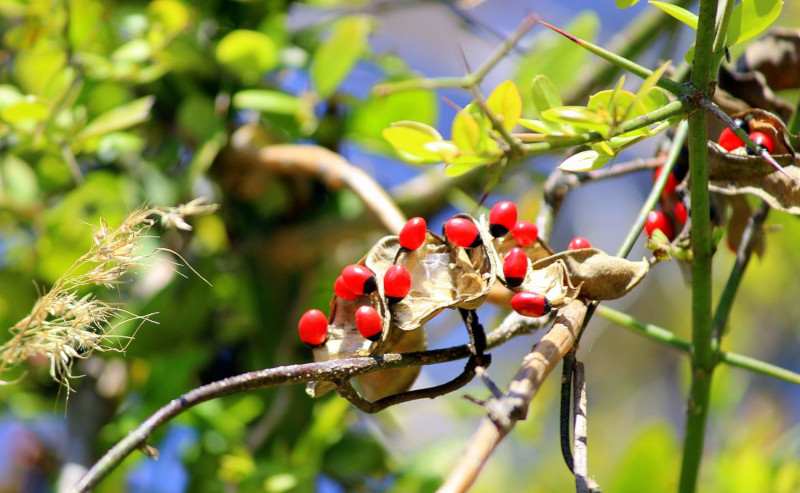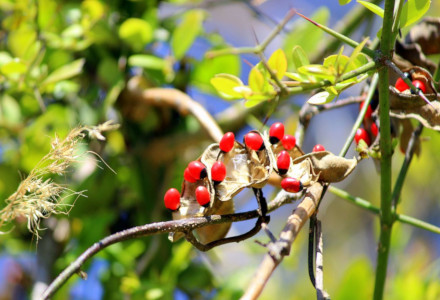
Rosary Pea Facts
- First of all, the term Rosary Pea serves as the common name for an extremely remarkable variety of herbaceous flowering plant. Also known by the scientific name of the Abrus precatorious, this plant proves that beauty can conceal danger.
- That’s due to the fact that the plant holds a dark secret. This innocent-seeming plant actually contains high quantities of a chemical compound called abrin. This chemical holds a very close relationship with the incredibly deadly chemical, risin.
- In point of fact, the consumption of even a single berry can prove fatal to an average-sized human being. Quite incredibly, despite this fact, the colorful berries of this particular flora have long been used by man for many purposes.
- Ironically, these ultra-deadly small fruits were long used for an astonishing purpose, given their toxicity. These formed the original source of the rosary beads used in worship. That, therefore, formed the basis of the common name for the deadly plant.
- For the moment, the remarkable Rosary Pea appears to have a stable population. Further, this fortunate situation seems to hold true throughout the entirety of its native range. As a result, the IUCN currently has no listing for it.
- Nevertheless, the lovely but dangerous plant likely faces several threats to its continued existence. Like many species today, these likely include the danger of habitat loss. But its greatest threat most likely consists of climate change.
Related Articles
Jade Vine Bleeding Heart Vine American Wisteria
Rosary Pea Physical Description
Firstly, botanists categorize the Rosary Pea as a legume. This occurs because this perennial plant develops in the form of a slender, climbing vine. In addition, the species frequently twists its way around trees, hedges, and shrubs.
Secondly, its leaves develop as quite slender, and roughly 5 in (12.7 cm) long. Further, the thin branches develop as herbaceous in nature. The flowers remain small and show either white, violet, or pink, and typically grow densely clustered.
Thirdly, the deadly seeds of the fascinating plant develop within small pods. These average roughly 2 in (5.1 cm) in length. Each pod contains 3-8 of the seeds, and thankfully, the shell of each produces a relatively thick and hard covering.
Finally, the seeds of the Rosary Pea themselves appear in different color varieties. However, the red color with a black spot remains the most common of the combinations. Nevertheless, white, green, and black seeds occur as well.
- Kingdom: Plantae
- Phylum: Angiosperm
- Class: Eudicots
- Order: Fabales
- Family: Fabaceae
- Genus: Abrus
- Species: A. precatorius
Rosary Pea Distribution, Habitat, and Ecology
The remarkable Rosary Pea evolved as endemic to several continents. These include the regions of Asia, Africa, and Australia. However, this remarkably adaptable species has now been spread to most regions of the world with compatible climates.
These areas into which it has been artificially introduced include the Caribbean Islands, Belize, Hawaii. In addition, this also includes parts of that state of Florida, in the United States, in North America, as well as the country of India.
Although it did evolve as a highly adaptable species, the plant nevertheless has types of climate that it prefers. These primarily consist of regions of subtropical forests. Although it’s quite tolerant of most types of soil, it flourishes best where that soil is well-drained.
It most commonly spreads via the distribution of its numerous seeds. These seeds, created in vast numbers, remain viable for an entire year. Due to this aggressive nature, in these regions, people generally consider the Rosary Pea an invasive species.
That’s true because it has proven to be extremely adaptable, and difficult to eradicate in these areas. This occurs partly because its roots grow extremely deep and nearly impossible to remove. In fact, burning, intentional or otherwise, actually encourages it to grow.
Species Sharing Its Range
Cougar Chinese Lantern Indian Bullfrog
Check out our other articles on 4 Geological Wonders of Antarctica, Pesquet’s Parrot, Gorges du Tarn, Green Orchid Bee, Geoffroy’s Cat, Japanese Angelshark, Plumed Basilisk

